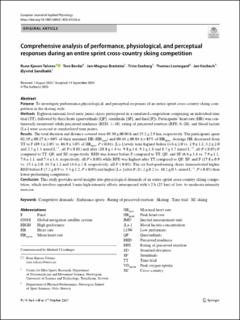| dc.description.abstract | Purpose: To investigate performance, physiological, and perceptual responses of an entire sprint cross-country skiing competition in the skating style. Methods: Eighteen national-level male junior skiers participated in a simulated competition comprising an individual time trial (TT), followed by three heats (quarterfinals [QF], semifinals [SF], and final [F]). Participants’ heart rate (HR) was continuously monitored while perceived readiness (RED, 1–10), rating of perceived exertion (RPE, 6–20), and blood lactate [La-] were assessed at standardized time points. Results: The total duration and distance covered were 03:30 ± 00:06 h and 25.2 ± 2.9 km, respectively. The participants spent 02:19 ± 00:27 h > 60% of their maximal HR (HRmax) and 00:16 ± 00:04 h > 85% of HRmax. Average HR decreased from TT to F (89.3 ± 2.0% vs. 86.9 ± 3.0% of HRmax, P < 0.01). [La-] levels were highest before (4.6 ± 2.0 vs. 2.9 ± 1.2, 3.2 ± 2.0 and 2.5 ± 1.3 mmol·L−1, all P < 0.01) and after (10.8 ± 1.4 vs. 9.8 ± 1.6, 9.1 ± 1.8 and 8.7 ± 1.7 mmol·L−1, all P < 0.05) F compared to TT, QF, and SF, respectively. RED was lowest before F compared to TT, QF, and SF (6.6 ± 1.4 vs. 7.9 ± 1.1, 7.6 ± 1.1, and 7.4 ± 1.4, respectively, all P < 0.05) while RPE was highest after TT compared to QF, SF, and F (17.8 ± 0.9 vs. 15.1 ± 2.0, 16.5 ± 1.2 and 16.6 ± 1.8, respectively, all P < 0.01). The six best-performing skiers demonstrated higher RED before F (7.2 ± 0.9 vs. 5.3 ± 1.2, P < 0.05) and higher [La-] after F (11.2 ± 0.2 vs. 10.2 ± 0.3, mmol·L−1, P < 0.05) than lower-performing competitors. Conclusion: This study provides novel insights into physiological demands of an entire sprint cross-country skiing competition, which involves repeated 3-min high-intensity efforts interspersed with > 2 h (25 km) of low- to moderate-intensity exercise. | en_US |

